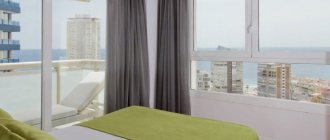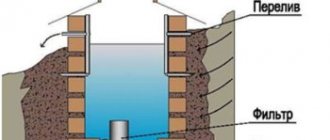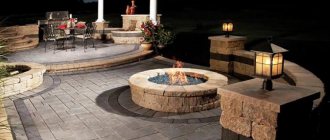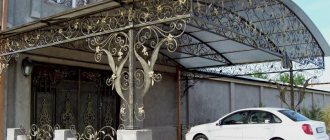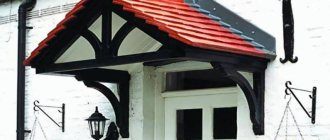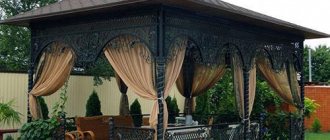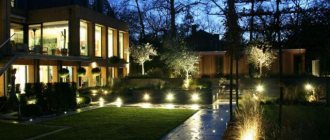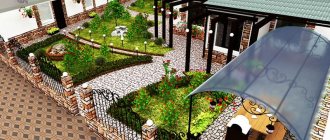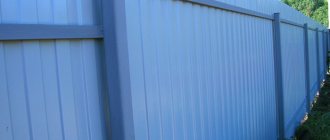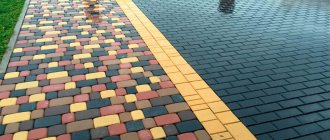Artistic lighting of the façade of a building is a relatively new and popular trend in the field of lighting design. The main purpose of lighting is to make a building more attractive and original. Thanks to proper lighting, you can hide the shortcomings of an architectural building, highlight its silhouette and emphasize the status of the homeowner. At the same time, facade lighting can perform not only an aesthetic function, but also provide comfortable living and recreation conditions at night. By the way, for Moscow residents we can recommend an excellent company Svetville.ru
Flexible neon
This light illumination can be called differently, flexible or cold neon, or more scientifically - electroluminescent cord (El cord).
It glows due to the phosphor in the central core, and voltage is supplied through it through two very thin wires.

Cord tubes can be of any color. Here you can choose according to your taste and color. However, unlike LED RGB strip, the color of neon cannot be changed arbitrarily.

Whatever color cord you bought in the store, this shade will illuminate your façade. There are indeed models with the “crawling snake” effect, but they cost a little more.
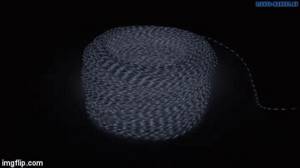
For more details on all the varieties of El cord, how to choose it correctly, what advantages and significant disadvantages it has, read the article at the link below.

Neon cord is a rather unpretentious product. You can bend it at different angles, which is very important on complex and curvy facades.

It consumes very little electricity - about 4 W/m. At the same time, it is ideal for installation outdoors on any surface, as it is not afraid of moisture.
And it practically does not heat up. Therefore, there is no need to worry that it may cause the wooden structures of the attic to catch fire.
More details
Another undoubted advantage over LED tape or garlands is its universal length. Neon can be cut with millimeter precision, absolutely anywhere.

At the same time, it’s easy to build up and solder additional pieces of completely different colors.
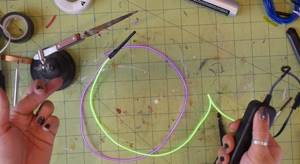
It is most often attached to the facade by conventional gluing with sealant or Moment glue.
Slight difficulties may arise with connecting cold neon. The fact is that you can’t just plug it into a socket or 220V network. To power it, a special inverter is required.
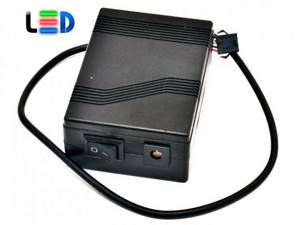
On the one hand, this is inconvenient, but on the other hand, it makes it possible to connect it not only from an outlet, but also from battery-powered inverters.
In fact, you don't even have to run any wiring outside. It is enough to hide a sufficiently powerful battery pack in the attic or under the canopy.
Taking into account the low power of the backlight, such power can easily last for a couple of nights. With spare batteries, your facade will glow all night long without interruption.

If you prefer standard 220V, and don’t want to climb into attics and roofs every time to change batteries, then don’t forget about the adapter. It's something like a phone charger.

It reduces the voltage from 220V to 12 or 24V. It is from them that cold neon inverters need to be powered.
The conductors are connected either using a soldering iron or through factory male-female connectors already soldered to the cord.

Recommendations
When arranging outdoor lighting, you need to act according to the advice of experienced craftsmen in the field of repair and construction. According to their recommendations, lighting devices used for architectural lighting must meet the following requirements:
- Multifunctionality - combining lighting and decorative functions.
- Weather protection.
- Safety in operation.
- Economical energy consumption.
- Simple and quick installation.
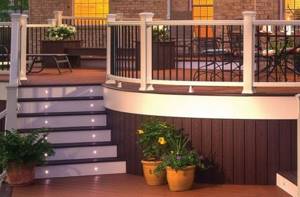
The following nuances should also be taken into account:
- Do not connect aluminum and copper wires.
- The lamp body must be aluminum. An alternative solution is a body made of acrylic or polycarbonate.
- Lamps for outdoor use must be at least IP65.
- It is better to conduct LED lighting through a transformer.
- Voids and differences can be played out with the help of flood light.
- It is obligatory to highlight the sign with the house and street number.
LED garlands
The most popular facade lighting today is LED garlands.

Moreover, they can decorate not only the walls and roofs of a building, but also trees in the garden, gazebos, windows, paths.
1 of 3
It all depends on what type of garlands you buy in the store.

The fringe is usually installed on the roof. The light curtain is hung outside the window, and its train is cut to fit the windows.
Previously, small incandescent light bulbs were used in garlands and this was not always safe. And they only served for a maximum of one or two winters.

After switching to LEDs, the quality and durability of such products has increased significantly.

And energy consumption has also dropped. The connection diagram for the lighting elements is also of great importance. In lamp garlands, if connected in series and at least one bulb was damaged, the entire backlight stopped working at once.
LEDs use a parallel circuit. When one diode burns out, only a small segment or a separate block of the garland stops shining.
The remaining meters are burning as if nothing had happened. Thanks to this, you can hang the garland in the most inaccessible places without fear. You won't have to go to them again to change light bulbs.
1 of 4
The most important thing when choosing outdoor garlands is to look at the level of moisture protection. It must be at least IP65.
All other options are for indoor use and hanging on the Christmas tree only.
Decorative lighting of buildings in a suburban area - principles and rules
The illumination of a house and other buildings can be very diverse. It can be formed from LED strips, bright lanterns or hidden lamps. The direction of their light flows depends on what needs to be emphasized on the façade and what is best hidden. Some design techniques allow you to make mistakes or flaws when decorating the facade with their advantages.
For example, by directing the flow of light across minor irregularities, you can create an original decorative effect, and the synchronous change of light and shadow looks great on stepped stone or brickwork. A constant, even stream of soft light from below is suitable for smooth, monochromatic brickwork.
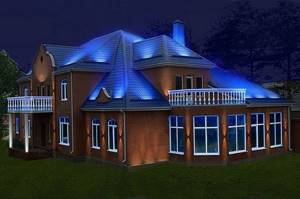
Decorative lighting of secondary buildings - gazebos, barbecue areas, ponds and other small objects - looks original in a suburban area. Only one rule must be followed - it should not be brighter than the lighting of the house itself. For them, it is better to choose compact lamps or diode strips in a single color scheme, without flickering effect, and place them along the contour of the building.
Should a fence (enclosure) be made part of the decorative lighting of a suburban area? Many designers agree that it looks vulgar. Illuminate, mark with lamps or lanterns, it is better to just enter the territory.
How to secure
Garlands are hung on trees according to the “fluffiness” of the branches and attached to them using plastic cable ties or clamps.

For facades you will have to look for special clamps with dowels or screws included. Or with a hole for them.

As a rule, they are drilled once and left in the wall in this form until the next winter. In the spring, simply freeing the wires from the clamps.
If you are not ready to damage the wall, then you can only create lighting decorations on windows, cornices, gutter overhangs, etc. It won't be as impressive, but it will leave your home intact.

On the above facade elements, the wires can be attached painlessly using the same clamps or glued cable pads. And in the spring, remove the whole thing and put it off until next year.
The connection of the garlands will depend on their voltage. There are models designed for 220V and 12-24-36V.
Those powered by a 220V network are considered the least safe. They should not be placed along paths, metal fences or other places where accidental human touch is possible.
Still, street operating conditions still affect the technical condition of the insulation. Such garlands do not require low-voltage power supplies and will require separate 220V wiring.

And such products, as a rule, have a serial connection circuit. Accordingly, you will not be able to extend or cut off an additional few meters of the garland at will.
Moreover, if there are several different pieces of them on the facade, then a separate power wire will have to be pulled to each one. Remember that they all have a very short factory cable (the one with the plug).
You won’t put a separate socket next to each garland and turn it on and off every time. Therefore, installers always cut off the plugs and extend the factory wiring, connecting it in parallel with other lighting elements.

Of course, experienced homeowners sometimes install a couple of street outlets at the construction stage. Both on the facade of the house and in the courtyard area near the paths.
1 of 2
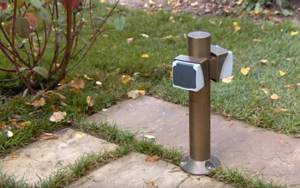
But most of you, unfortunately, do not have this.
When installing hidden wiring, use the correct cable that will last outdoors for many years. For example, the same VVGng with insulation resistant to ultraviolet solar radiation, cross-section up to 1.5 mm2, and not PVA.

Make connections in a protective junction box to the self-clamping terminals of the car. They will allow you to painlessly connect and, in the spring, disconnect the monocore of the VVG cable from the flexible power wires of the garland.

From this distribution box you will have only one cable going into the house. And it is he who will connect to the 220V network. You can simply connect it through a separate switch or from a relay with a light sensor.

By the way, the connection diagram can be used the same as that widely used for street lighting in a country house.
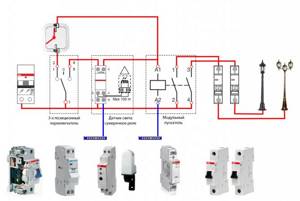
It will work both automatically and manually.
Do not forget that when installing lighting in a two-story house, you cannot do without a rafter system or special lifts. Consider the costs of these mechanisms in advance.
1 of 3
Low-voltage garland models are connected via 12 or 24V power supplies. They may not always come as a set. Therefore, you will have to choose them yourself.

The most important thing here is to choose the right power and, again, the degree of moisture protection.
Never choose them, as they say, end-to-end. Always do this with a margin of at least 20%.
Find out the power of your garland and multiply it by 1.2. Next, look at the step-down blocks closest in terms of watts and select the appropriate one.
Types of lighting fixtures
As you know, all artificial light sources are divided into three categories: hidden lighting, local and flood light. The lamps themselves can have the following varieties:
- A spotlight is an LED or halogen lighting device with a bright directional light output. Depending on their location, they are divided into corner and panoramic.
- Sconces are built-in lamps.
- Floor lamps are double-sided lamps that are highly functional. They are usually used to illuminate the entrance to a site or a house, as well as near signs with signs.
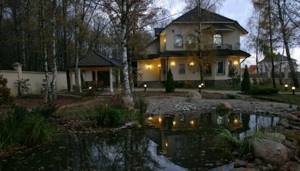
- Linear and strip lights are LED light sources that are a flexible strip, thanks to which you can highlight the contours of the roof, identify architectural elements of the facade, or make original drawings.
- Ground lamps are light sources that are installed along a concrete base or sidewalk paths. The main requirement is mechanical stability and a high level of protection from moisture.
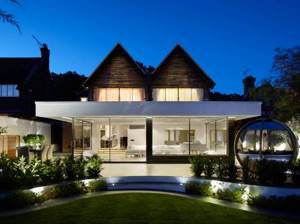
Duralight
The third lighting option is a kind of symbiosis of LED garland and cold neon. Chinese craftsmen once hid LEDs inside a PVC cord and got the so-called duralight.
It comes in two types - flat (duraflex) and round.
The most popular duralight:
- round section - 13mm with 32 LEDs per linear meter
- and rectangular shape 11*17mm 60 LEDs per 1m
Some varieties, just like flexible neon, can glow in a running fire mode. In addition, duralight can pulsate and flicker at a given frequency.

Today, this is no longer a particularly common facade lighting. And in some respects it is inferior to both neon and garlands.

For example, over time, duralight tubes will stretch and lose their original shape from year to year. Not to mention the fact that for many Chinese specimens, the insulation in the cold after one winter becomes completely unusable.
In terms of brightness, duralight is inferior to an LED garland. But it is worth noting the fact that this is the cheapest and easiest to connect New Year's façade lighting.

Therefore, those who are engaged in facade lighting for the first time prefer to buy it. It is sold in bays of several tens of meters.
Just keep in mind that you need to cut it off in strictly marked places, and not wherever you want. After cutting, the end is sealed with a special plug.
Wall mounting is carried out using mounting clips.

Despite the voltage being 220V, the connection must be made through an adapter that supplies direct current to the LEDs.

And if you want magical blinks and flickers, you will also need a controller.

Duralight can be expanded, but this is done through adapter couplings.
The 220V ends are also connected via pin contacts.

Video
The best posts
- Geometric wallpaper: 3 interesting options
- Houses like Arshavin’s: copying the interior of the famous football player
- DIY pencil case door: installation recommendations
- How to choose the right bed base
- Mosaic beadwork for beginners: master class with video
- Designer tips for choosing curtains and tulle for the kitchen
- How to sew rompers for a newborn with an elastic band with your own hands: pattern and sewing master class
- How and what is the best way to glue a plastic corner
What to choose?
Of all the types presented above, the most versatile and durable option is an LED street garland. Neon cord is also good, but it is significantly inferior in brightness.
Duralight can be recommended to those who have never dealt with facade lighting or have a meager selection of New Year's illumination in nearby stores.
And in the end, enjoy the chic interactive illumination of country houses, made by professionals in their field. It's really worth a look.

